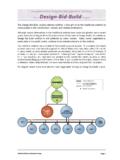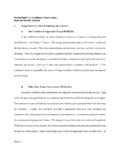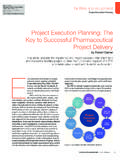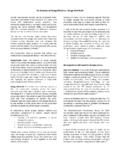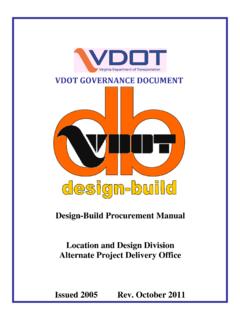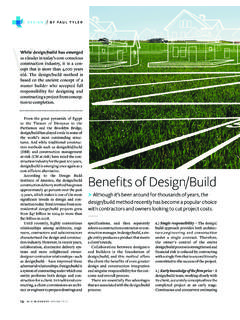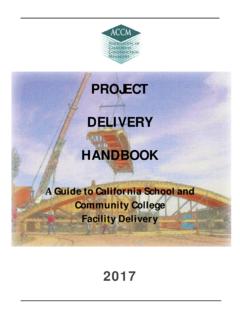Transcription of RISK ASSESSMENT OF DESIGN-BID-BUILD AND DESIGN …
1 Journal of the Operations Research Society of Japanc 2010 The Operations Research Society of JapanVol. 53, No. 1, March 2010, pp. 20 39 RISK ASSESSMENT OF DESIGN -BID- build AND DESIGN -BUILDBUILDING PROJECTST sung-Chieh TsaiMin-Lan YangNational Yunlin University of Science and Technology(Received November 30, 2007; Revised July 30, 2009)AbstractProjects managers normally seek to lower the extent of risk by signing contracts, such as DESIGN -Bid- build (DBB) or DESIGN - build (DB) project delivery systems to transfer or share risk over to other projectentities.
2 The main purpose of this study is doing risk ASSESSMENT from the perspective of clients, comparingproject delivery systems mentioned above to see, firstly, what risk factors are, and, secondly, to analyze theranking of risk factors and amount of risk with temporal sequencing change over different project stages( proposal surveying, scheme designing, procurement contracting, and construction receiving). Thus,identify risk factors using literature reviews and conduct survey with clients; utilize the fuzzy numberswith integral value to simulate the changes of ranking of risk factors and the amount of risk with temporalsequencing, given different the attitude of decision makers in risk management (pessimistic, neutral, or op-timistic) of the decision-makers towards risk, meanwhile, consider information accuracy in decision-makingenvironment.
3 The result shows that DESIGN -Bid- build mainly concern about quotation, cost, drawing spec-ification, etc. Furthermore, many risks arise in earlier stage, such as proposal surveying stage and schemedesigning stage, that the practice of DESIGN - build should exert precaution to prevent likelihood of contrac-tors using inferior materials to cheat profit out of affirmed bidding assignment, drawings, etc., and thatrisks are higher in proposal surveying stage and procurement contracting : Risk management, DESIGN -bid- build , DESIGN - build , project delivery system,fuzzy sets1.
4 IntroductionBuilding project must consider the environmental impact of the job, the successful schedul-ing, budgeting, site safety, availability of materials, logistics, inconvenience to the pub-lic caused by construction delays, preparing delivery system documents, etc. From theperspective of risk management, given building projects featuring high risk and complexrisk structure, clients normally seek to lower risk by adapting some kind of risk strate-gies, such as project delivery system, to transfer risk or share risk to other project enti-ties [7,12,18,31].
5 Literature also agree that risk can be tactically controlled to some certainextent [6,21,26,34], with specific means that tend to allow risks to be transferred or sharedto other project entities [12,18]. A project delivery system is defined as a method forprocurement by which the clients transfer or share risks to other project entities. Theseentities typically are a DESIGN entity who takes responsibility for the DESIGN and a contractorwho takes responsibility for the performance of the construction. In Taiwan, DESIGN -Bid- build (DBB) is a conventional way that is also widely used in different countries and hasbeen applied in different building projects, while DESIGN - build (DB) is another alternativeproviding clients with various options of choices.
6 For the clients, the selection of projectdelivery system in the past would mostly rely on personal experiences [19], and as found byMok [22], 80% of project managers still depend on subjective views or experience to weigh20 Risk ASSESSMENT of DBB/DB Building Projects21risks without the ASSESSMENT of risk strategies in effective and systematical manner, andthese are the options available for project delivery demonstrating a schematic chart of risk allocation from the perspective of risk man-agement, Iweeds [31] indicated project delivery systems being effective strategies for riskthat allow the transferring and sharing of risk (as shown in Figure 1).
7 Some recent studiesthat developed to assist project managers in selecting project delivery systems. Gordon [10]adapted the method of cancellation, by the ASSESSMENT index of project delivery system se-lection, to remove those non-conforming project delivery systems and keep the appropriateones; Spink [28] divided the considerations for project delivery system selection into twogroups, with one being the considerations given to conditions available for the clients, theother given to project -related factors, while decision-makers are allowed to weigh the signif-icance of one factor against the other, and render pros and cons of the project delivery sys-tems.
8 Khail [15] and Mahdi [23] applied the method of Analytical Hierarchy Process (AHP)in their studies to calculate the weighed rating of the ASSESSMENT index for project deliverysystems, which provides clients with reference in the selection of project delivery systems;Konchar and Chong [14] applied the statistic method of multivariate regression analysis tocompare the advantages of construction management, DBB, and DB against the assessmentindices of cost, delivery and quality; furthermore, Ling et al. [20] compared the advantagesand disadvantages of DB and DBB project delivery systems by the construction progressionand completion 1: Schematic chart on risk transferring and distribution [31]Although these studies are useful for risk strategies selection, they are limited in theirapplicability to real construction risk identification and analysis.
9 Many clients are firstconfronted with the problems of not knowing, what risk factors need to be evaluated, andnot knowing the significance ranking of each risk factor nor the amount of risks that mightoccur over different project stages, given the project delivery system they have selected, sothat they cannot take appropriate strategies against the risks based on the kind of managerialadvantages they suggested by literatures of previous studies, prior to the decision on project deliverysystem, considerations should be given to the matter of risk transferring or sharing in order tosave time, cost and to improve quality [12,18].
10 That meant selecting the appropriate projectdelivery system from risk management perspective, requires evaluating large amount of riskdata, that are extensive and consensus will be able to serve as reference for the clients to dosubsequent risk analysis and to effectively manage project risks in order for the project goalto be achieved [2]. The main purpose of this study, therefore, is to do risk ASSESSMENT fromthe perspective of clients, comparing the project delivery systems of DBB and DB from theviewpoint of risk management, to firstly see what the risk factors are, and secondly analyzethe significance ranking of these risk factors and amount of risk with temporal sequencingchange over different project stages ( proposal surveying, scheme designing, procurementcontracting, and construction receiving).



